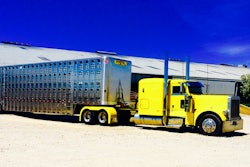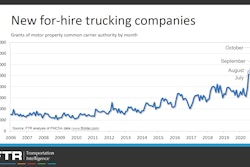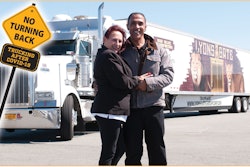Previously in this series: Volatile year shows growing pains of in-app freight pricing, value of negotiation
Since the COVID-19 pandemic was declared after spread to the United States’ and so many other countries’ shores early in the year, fleets, owner-operators and their tech vendors of varying stripes have devised a variety of ways to limit close contact between front-line operators and office staff, customers and others whose interaction is a part of doing the business of trucking.
The replacement of paper bills of lading with electronic versions, and the digital hand-off of the BOL for signatures for proofs of delivery (POD), have been talked about and executed in some forms by trucking companies in collaboration with vendors and customers for a substantial amount of time, according to Frank Adelman, CEO of document-management system and electronic logging device provider (and more) Transflo. The relatively recent eBOL and complementary ePOD functions enabled by Transflo’s system are in part a result of Transflo’s carrier customers sending “their shippers to Transflo” with the message that, Adelman said, if the company could effectively “digitize the work between us and our drivers,” surely there’s a way to integrate carrier/customer systems for paperless/contactless handoffs at the docks.
Adelman added the company had such a solution “on the drawing board for years.” Yet with demand to eliminate touch points — whether via those paper bills themselves or the simple fact that, to get a physical signature, including on a single touchscreen, contact between two people is a requirement — COVID has “really placed the ‘contactless world’ on a level of importance” it’s never had in trucking. At the same time, uptake of such solutions has been slow to come to the wider trucking world. Just one in 10 owner-operators in Overdrive‘s audience reported utilizing digital signature techs on most every load.
Yet there’s plenty evidence of new implementation. Take the example of Michigan-based Van Eerden Trucking. Steele Roddick, with the Microdea company (purchased by Transflo in the fall), noted at the beginning of the pandemic, “out of an abundance of caution” the approximately 150-truck Van Eerden was “quarantining bills of lading” for extra time to prevent potential virus transmission from the road to the office. That quarantine of physical documents was “causing significant billing delays,” given new lag time from delivery to getting invoices out to customers.
Microdea’s digital-document platform, said Roddick, with a custom smartphone app for Van Eerden drivers, enabled the company to digitize the bills of lading and get them back immediately in digital form.
The company’s invoicing system got back up to speed — but was quicker than ever thanks to the new solution.
The example illustrates a point Transflo’s Adelman made about his company’s electronic tools for carriers large and small in the present moment. Thanks in part to the pandemic, there’s “heightened awareness” of the health and safety benefits of digitizing workflows down to the level of the interaction with shippers and receivers, he said. Yet “having visibility into things in a paperless format” holds the potential to squeeze out “tons of efficiency” from the business, he said.
Do you utilize electronic mobile signature capture with receivers of your loads?
 Only 1 in 4 Overdrive readers have moved beyond all-paper environments when it comes to signatures at pickup and delivery, and most of that 26% only on the occasional load. Of those who’ve gone digital for the interaction on most every load, more (6%) were using a system of their own or their direct customer’s devising than a fleet’s technology (4%), perhaps an indication of the growing sophistication of mobile apps and the myriad tools available to one-truck independents and small fleets. The Super Dispatch app, for instance, popular in particular with hotshot and other car haulers, introduced its own “Touchless Delivery” feature back in June. It allows a driver to sign-off on pickups and deliveries on his own mobile device, then initiate an SMS text message to the customer with a link to where they can sign with their device, saving signatures with relevant load documents in the cloud. Thus: eliminating close contact.
Only 1 in 4 Overdrive readers have moved beyond all-paper environments when it comes to signatures at pickup and delivery, and most of that 26% only on the occasional load. Of those who’ve gone digital for the interaction on most every load, more (6%) were using a system of their own or their direct customer’s devising than a fleet’s technology (4%), perhaps an indication of the growing sophistication of mobile apps and the myriad tools available to one-truck independents and small fleets. The Super Dispatch app, for instance, popular in particular with hotshot and other car haulers, introduced its own “Touchless Delivery” feature back in June. It allows a driver to sign-off on pickups and deliveries on his own mobile device, then initiate an SMS text message to the customer with a link to where they can sign with their device, saving signatures with relevant load documents in the cloud. Thus: eliminating close contact.Bonnie Ramsay, Chief Information Officer for Superior, Wisconsin-headquartered Halvor Lines, met the pandemic with a mission to keep down virus transmission among staff — that of course includes those on the front lines moving the freight. The company employs well more than 400 company drivers and contracts with more than 100 owner-operators as well.
Ramsay and company very early on invested in hardware necessary to send 75% of office employees to work from home, where most remained as of this fall. When drivers are at the main building, “they’re able to come in one door of our building, and it’s a one-way direction” through the office, Ramsay said. “We’ve got plexiglass between those who remain inside.”
Early on in the pandemic, when sustenance on the road was a real challenge, “12,000 box lunches for drivers went out” over the course of the first three months, she added.
She also worked with Transflo and her in-house developer to remove the necessity of face-to-face interactions at the docks.
From a driver’s perspective the current system in place starts with a button on their Transflo mobile app. “We named it ‘Halvor eBOL,'” Ramsay said. Tapping it gives the driver three options.
- Scan in an unsigned eBOL (using the mobile device’s camera)
- Request a signature from a receiver
- Review paperwork activity
Upon execution of No. 1, the system captures the image in cloud storage and Halvor’s EBE Ships document-management software converts it to a pdf. At delivery, then, the driver can execute No. 2, punch in the order number and the system grabs the pdf and, in concert with the SignEast vendor’s e-signature software (allowing for both mobile and digital signature capture), sends to the receiver contact’s email address.
The process for multi-stop loads was a bit complicated to set up, but Ramsay and company devised a naming convention system based on the stop information that made it easier to both set up and execute.
The driver has access to “the status of all of this,” Ramsay said. “They can see we’ve received [the BOL] and their signature request and that we’ve sent it. Once the signer signs, we are monitoring the signature capture environment for those documents. It pulls it back, and once we have it back in-house – then it’s sent to our billing and settlements department.
“Now, for the driver, they’re free to go, free to leave. And we have all the information needed to pay the driver.”
 Read more in this series — from shifts in owner-ops’ experience of the nation’s truck stops to expanding telehealth options and contract opportunities– via this link.
Read more in this series — from shifts in owner-ops’ experience of the nation’s truck stops to expanding telehealth options and contract opportunities– via this link.There’s that added bonus for the time put into development again — faster settlements for drivers and leased owner-ops at Halvor Lines.
“I can’t stress enough how important it is that we do our best in all our roles to care for each other during this time,” Ramsay added. “If I can help a driver stay safe, it’s well worth it.”
And though a desire for face-to-face interaction is a basic instinct in the human endeavor, “It’s important that we all keep our thinking caps on … to mitigate those face points, unfortunately.”









